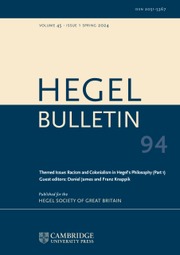Article contents
Artisans, Artists and Hegel's History of Art*
Published online by Cambridge University Press: 23 August 2013
Abstract
This article examines Hegel's use of the distinction between ‘artist’ (Künstler) and ‘artisan’ (Werkmeister) in light of recent discussion about the ‘end’ of art and the distinction betweeen art and craft that, as some have argued, has been central to the concept of the fine arts since the eighteenth century. Hegel does employ an important distinction between artist and artisan, but he does so within a larger account of the continuum of forms of human making that can take into consideration the importance of the artisan's work as well as the artist's. Hegel's account involves two distinctive features not always at issue in the artist/artisan distinction: the stress on the social changes required for new forms of art to emerge and an embrace of the human being as the essentially retrospective and interpretive animal in whom the decisive intersection of content and form finally makes art what it is.
- Type
- Articles
- Information
- Copyright
- Copyright © The Hegel Society of Great Britain 2013
Footnotes
An earlier version of this paper was presented at the meeting of the Hegel Society of Great Britain at Magdalene College Cambridge in September 2012. I am grateful to the participants in those meetings for numerous points of discussion, and particularly to Stephen Houlgate, Dan Dahlstrom, Alison Stone, Katerina Deligiorgi and Joshua Billings for additional suggestions and queries.
References
- 3
- Cited by


